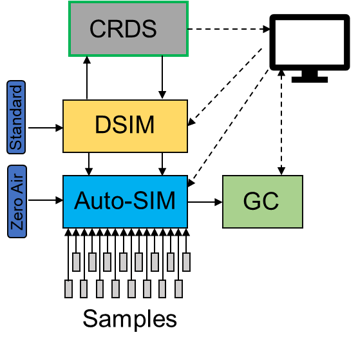Capabilities
Gas Hydrates Project Biogeochemistry Laboratory capabilities and instrumentation.
Gas Hydrates Project Dissolved Organic Carbon-IRMS Instrumentation
With support from the U.S. Department of Energy and in cooperation with the Woods Hole Oceanographic Institution, Gas Hydrates Project scientists maintain a high-temperature dissolved organic carbon (DOC) oxidation interfaced to an isotope ratio mass spectrometer (IRMS) that permits the analysis of DOC from fresh and saline waters. This instrument supports Gas Hydrates Project research and other scientific projects carried out at the USGS and by other WHOI collaborators.

Specialized Gas Chromatography (GC)
Gas hydrate scientists also maintain a customized Shimadzu 2014 GC with multiple detectors for comprehensive analysis of N2, O2, CO, CO2, H2, N2, O2, N2O, methane (CH4) and higher order hydrocarbons through hexane (C6). Semi-volatile higher molecular weight compounds are analyzed by the addition of capillary column.

Cavity Ringdown Spectrometry for Greenhouse Gas Applications
A centerpiece of the Gas Hydrates Project biogeochemistry program is three Picarro cavity ringdown spectrometers (CRDSs) that are used to analyze the concentration and carbon isotopes of CH4 and CO2 in air, water and discrete samples. When connected to an equilibrator and a sampling/plumbing system, the CRDSs have been extensively used by the Gas Hydrates Project for underway, real-time, continuous measurements of CH4 and CO2 during marine expeditions in the Arctic Ocean, on the U.S. Atlantic margin, and in the North Sea. The resulting measurements map CH4 hotspots in the surface ocean and allow calculation of sea-air methane and CO2 flux when combined with data from a YSI Exo2 sonde and ship’s navigation and weather systems. The stable carbon isotopic data collected during the same surveys constrain the sources of methane detected in the near-surface ocean.

The CRDSs have also been used to expand the Project’s analytical capabilities. Gas Hydrates Project scientists have developed a discrete sample introduction module (DSIM; U.S. patent pending), which is a peripheral that allows the CRDS to analyze discrete water samples containing dissolved gases. The resulting data provide not only the concentration, but also the stable carbon isotopic signature, of greenhouse gases in the sample in nearly real-time. The DSIM thus allows researchers to avoid the delays of weeks or months associated with obtaining carbon isotopic data with traditional instrumentation once samples are returned from field locations. An additional benefit is avoiding sample storage, which can lead to degradation in the quality of samples or even changes in the characteristics of the analytes targeted by the measurement techniques. In 2021, Gas Hydrate Project researchers are finalizing automation and computer control of an upgraded DSIM that can process 16 discrete samples by CRDS and GC in quick succession.

Another innovation also relies on the Gas Hydrates Project’s CRDSs. Under development is system that automatically monitors the evolution of gases from massively parallel (16 simultaneous) incubations. With this device, project scientists can continuously measure (with no user intervention) the production and isotopic composition of gases produced from mesocosms subjected to a variety of treatments and redox conditions.

Clumped Methane Isotopes
USGS scientists collaborate with other institutions (MIT, Caltech) to measure methane isotopologues (also called clumped isotopes) that can reflect the temperature at which methane formed or kinetic effects due to methane formation. Clumped methane isotopes are a relatively new analytical approach and can provide insight on the relative depth of methane formation in gas hydrate systems.

Solid Phase Geochemistry for Diagenetic Studies
Sediment burial brings organic matter into the subsurface at variable rates, which drives evolving pore water and microbial community compositions. USGS scientists collaborate with other institutions to measure the quantity and variety of organic matter, as well as diagenetic solid phase minerals (carbonates, sulfides, sulfates), that precipitate during burial. Characterization of these authigenic minerals, either directly or through elemental, isotopic, or magnetic proxies, provides a snapshot of past porewater conditions and biogeochemical processes, revealing past episodes of methane release, oxidation, or generation in gas hydrate-bearing sediments.

Any use of trade, firm or product name is for descriptive purposes only and does not imply endorsement by the U.S. Government.

